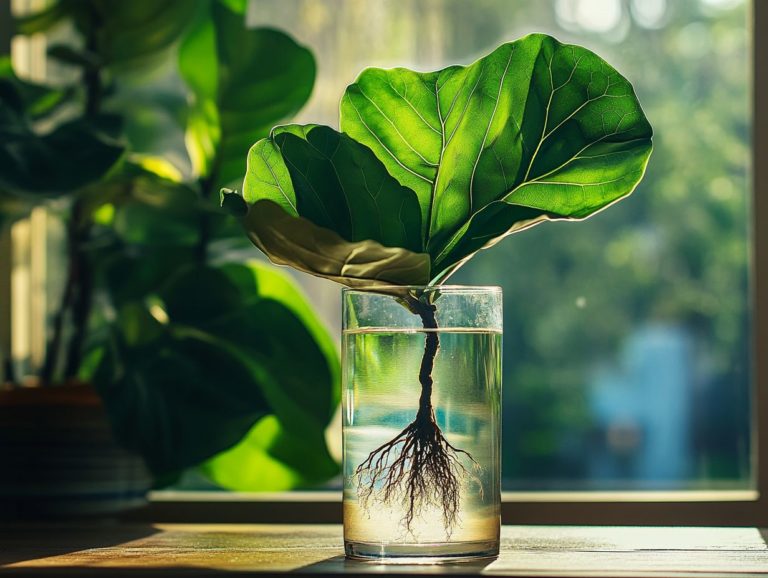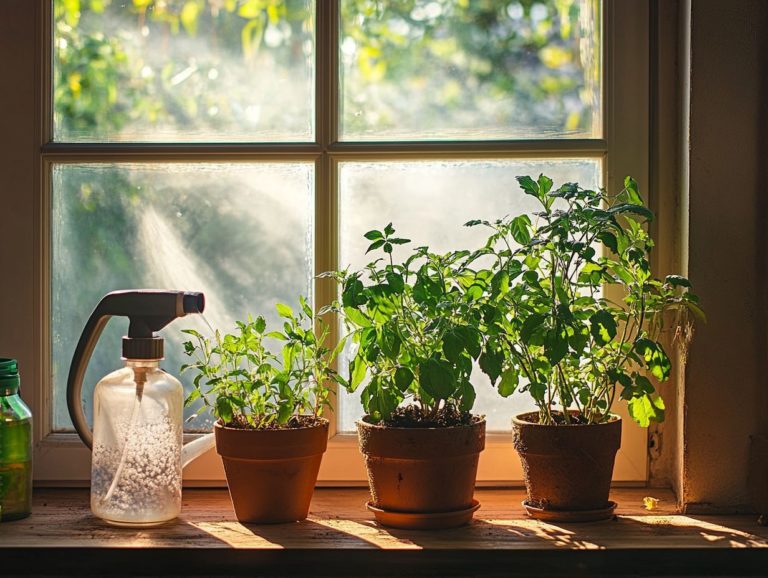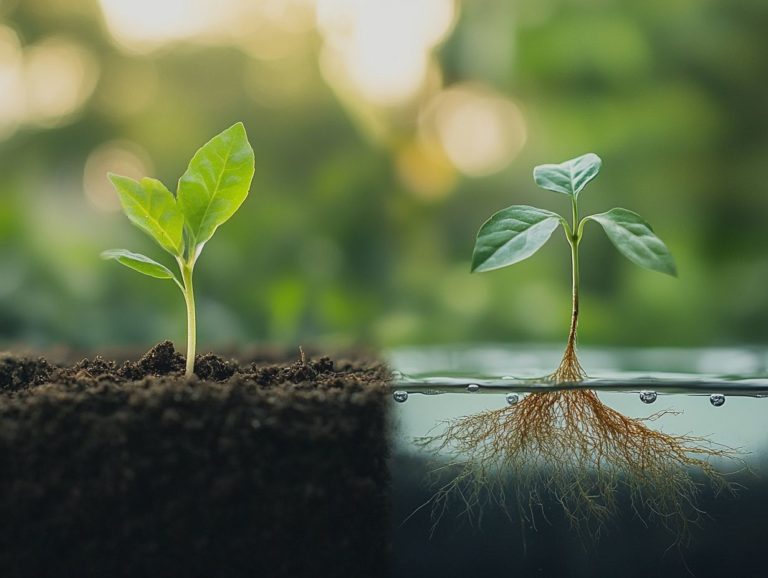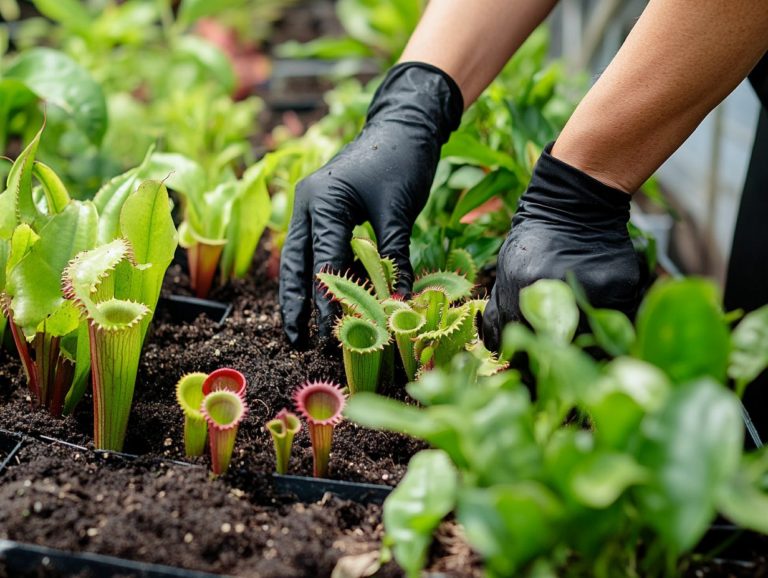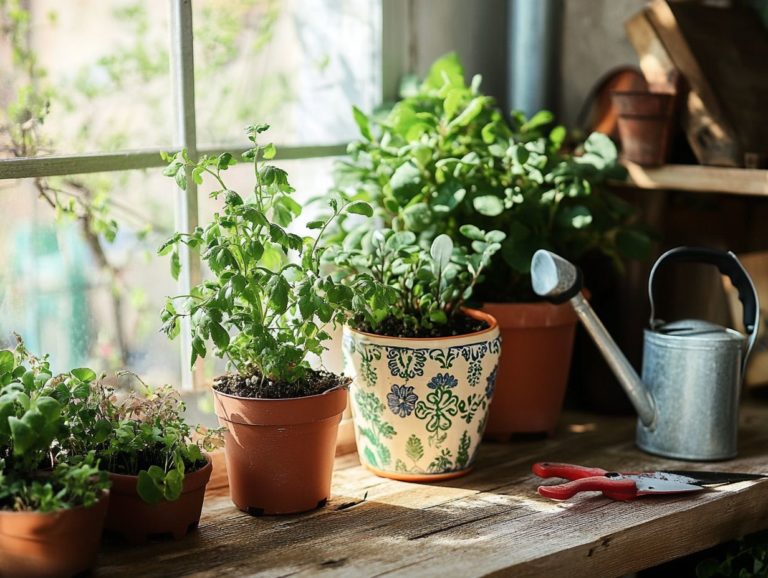Best Indoor Plants for Propagation
Are you eager to expand your indoor garden while keeping your budget intact? Plant propagation is your secret weapon for multiplying your favorite houseplants.
This process not only enriches your space but also showcases your green thumb. This article will guide you through essential plant propagation methods like water propagation and air layering.
You ll uncover the myriad benefits of propagating indoor plants, learn how to care for them effectively, and discover the essential tools you’ll need.
Are you ready to elevate your skills and become a propagation expert? Let s dive in!
Contents
- Key Takeaways:
- 1. What Is Plant Propagation?
- 2. Benefits of Propagating Indoor Plants
- 3. Basic Tools and Materials Needed for Propagation
- 4. Water Propagation
- 5. Stem Cutting Propagation
- 6. Leaf Cutting Propagation
- 7. Air Layering Propagation
- 8. Division Propagation
- 9. Grafting Propagation
- 10. Tips for Successful Propagation
- 11. Common Mistakes to Avoid
- 12. Best Indoor Plants for Propagation
- Which Method of Propagation Is Best for Different Types of Plants?
- What Are the Factors to Consider When Choosing Plants for Propagation?
- How Can One Create an Ideal Environment for Propagation?
- What Are the Common Problems Faced When Propagating Indoor Plants?
- How Can One Care for Newly Propagated Plants?
- Frequently Asked Questions
Key Takeaways:
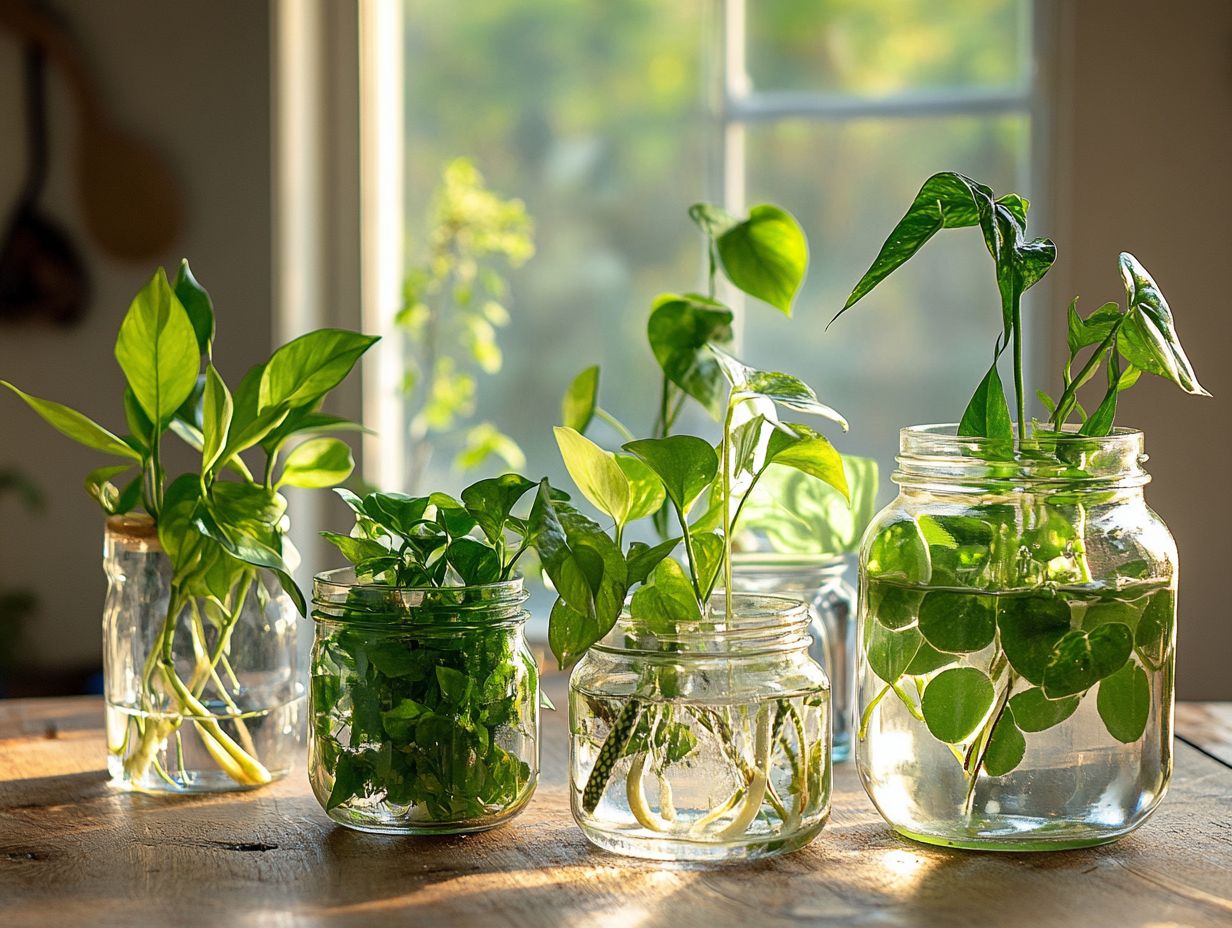
- Propagating indoor plants is an easy and cost-effective way to expand your collection.
- Some of the best plants for propagation include Spider Plants, Pothos, and Succulents.
- Creating an ideal environment and avoiding common mistakes are key to success.
1. What Is Plant Propagation?
Plant propagation is your gateway to creating new plants from the ones you already cherish. Whether through cuttings, dividing larger plants, or seeds, this practice allows you to grow your plant collection and supports a more sustainable environment.
Understanding how to propagate is essential for any gardener eager to cultivate their beloved indoor greenery. With methods like water and soil propagation, you can effortlessly grow plant babies like the vibrant Devil s Ivy, resilient Snake Plant, and iconic Monstera Deliciosa.
When you take cuttings from mature plants, you ll see new vines sprout quickly. The Snake Plant is easy to divide, making it great for beginners.
Many popular indoor plants thrive in water propagation, often sprouting roots in just weeks. The benefits of plant propagation extend beyond personal satisfaction; they reduce the need for new purchases, easing the strain on our natural resources.
Many find joy in nurturing their plants from tiny cuttings into thriving specimens. This journey fosters a deeper connection with their green companions.
2. Benefits of Propagating Indoor Plants
Propagating indoor plants offers a wealth of benefits. You can save money while enjoying the joy of nurturing your collection.
This fulfilling process deepens your understanding of plant care. Watching your plant babies grow boosts your gardening skills and confidence.
With the cost-effectiveness of propagation, you can reinvest those savings into better gardening supplies. The satisfaction that comes from watching a cutting develop roots is truly unparalleled.
This hands-on experience enhances your appreciation for plant care and nurtures patience and commitment. Beginners can enjoy success with popular houseplants like Pothos or ZZ Plants.
3. Basic Tools and Materials Needed for Propagation
To propagate your favorite houseplants successfully, gather the right tools and materials to nurture healthy plants from cuttings! You need sharp scissors or pruning shears for taking cuttings, along with clean containers filled with either water or soil.
Don’t forget the rooting hormone to encourage strong root development! A humidity dome or a simple plastic bag can help you maintain optimal moisture levels. With these tools, you can grow an impressive array of plants like Pothos, Monstera Deliciosa, and Heartleaf Philodendron right at home.
When using scissors or shears, always sanitize them to avoid harming your precious cuttings. Opt for clean, ideally transparent containers if you plan to root in water, as this allows you to visually track root development.
Using rooting hormone can speed up the process: just dip the cut end of your cutting into it before planting in the substrate. Covering your cuttings with a humidity dome or plastic wrap creates a mini greenhouse effect that traps moisture.
Remember to provide indirect light, as both Pothos and Monstera thrive in these conditions, leading to flourishing new plants!
4. Water Propagation
Water propagation is a popular method for nurturing plant cuttings. It allows roots to develop in water before transferring them to soil, making it an appealing choice for any plant enthusiast!
To start, select healthy cuttings from your chosen houseplant, ensuring they have a few leaves and nodes the small bumps on the stem where roots can grow. Trim the cut section at an angle, and gently remove any lower leaves that might touch the water.
Next, place these cuttings in a clear container filled with fresh, clean water! Ensure the nodes are submerged while the leaves stay above the surface. Change the water weekly to prevent bacterial growth and maintain optimal conditions.
Popular plants for this method include Pothos, String of Hearts, Spider Plants, and Philodendrons. For the best results, position your setup in a spot with bright, indirect light. This encourages rapid root development while avoiding direct sunlight, which can heat the water and harm the cuttings.
5. Stem Cutting Propagation
Stem cutting propagation is a favorite technique among houseplant enthusiasts! It allows you to create new plants simply by cutting a portion of the stem and encouraging it to root in either soil or water.
This method works particularly well for indoor plants such as the Snake Plant, Monstera Deliciosa, and Devils Ivy, which readily form roots under the right conditions. By mastering this technique, you ll not only expand your plant collection but also gain insights into effective plant care during the rooting process.
To successfully propagate a plant this way, start during the active growing season, usually in spring or summer. Select a healthy stem with a few leaves and nodes. Make a clean cut just below a node, then place the cutting in either soil or water, depending on your preference.
If you choose soil, keep it moist but not soggy. Change the water regularly for cuttings submerged in water to prevent stagnation. Providing warmth and indirect sunlight will also foster healthy rooting. With a little care, those young roots will develop, leading to robust new plants full of potential!
6. Leaf Cutting Propagation
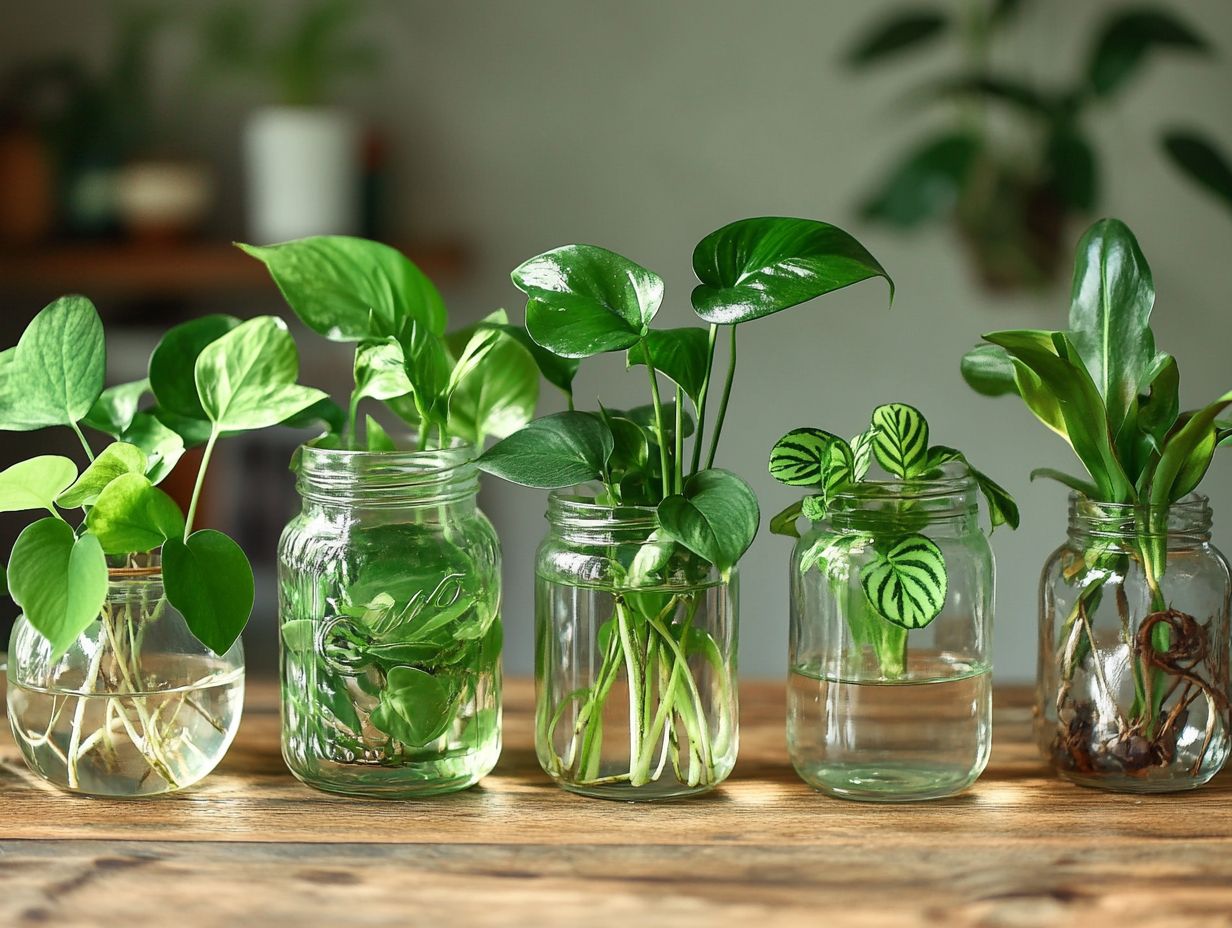
Leaf cutting propagation helps you grow new plants from healthy leaves. It’s perfect for brightening your indoor space effortlessly. This technique shines particularly for species like the Prayer Plant and Rabbit s Foot Fern, which thrive on leaf cuttings.
By carefully selecting healthy leaves and providing the right environment, you ll witness the magical transformation of simple cuttings into robust plants that make your indoor space more vibrant. Imagine watching your garden flourish!
To kick things off, choose mature, healthy leaves that are free from pests or diseases; these will be your foundation for success. When preparing the leaves, make clean, diagonal cuts to maximize surface area for moisture absorption.
Maintaining humidity is key. Consider using a humidity dome or a plastic bag to create an ideal microclimate for your cuttings. Bright, indirect light is your best friend it encourages faster rooting while steering clear of the stress that intense sunlight can impose.
This nurturing approach not only promotes growth but also brings satisfaction as you watch your indoor garden flourish.
7. Air Layering Propagation
Air layering is an amazing way to grow roots on a branch while keeping it on the plant. This technique makes it particularly suited for propagating larger indoor plants, like the Swiss Cheese Vine.
The method involves wounding the stem, applying rooting hormone (a substance that helps plants grow roots faster), and wrapping that area in moist sphagnum moss. As roots develop, you can carefully detach the new growth and pot it up, resulting in a thriving new plant.
Start by selecting a healthy branch and making a small cut around the stem this little incision will stimulate root growth. Next, generously apply rooting hormone to boost your chances of success. Wrapping the wounded area with sphagnum moss helps maintain moisture, and a plastic covering will keep the humidity just right.
Many plants, including ficus, magnolia, and various tropical varieties, respond beautifully to air layering, offering you promising results. Once you notice roots forming, usually after several weeks, handle the new plant with care as you separate it.
After potting, be sure to provide consistent moisture and indirect light, which will support your young plant as it establishes itself in its new home.
8. Division Propagation
Division propagation is a simple way to grow more plants in your indoor collection. It s especially effective for clumping varieties like the Barrel Cactus and Chinese Money Plant.
This technique involves skillfully separating the roots of the parent plant into smaller sections, each poised to grow into an independent specimen. By ensuring that each division boasts adequate roots and leaves, you can easily cultivate new plants that flourish on their own.
Timing plays a crucial role in successful division propagation. Do this in spring when plants are actively growing. The techniques for separating the plants may vary, but they generally entail carefully lifting the parent plant from its pot and gently teasing apart the root ball.
It’s vital to use a clean, sharp knife or scissors, ensuring that your cuts are neat and precise to minimize trauma to the plants. This approach is particularly rewarding with houseplants such as Snake Plant and Pothos, which tend to respond favorably to division.
Once you’ve completed the division, providing both the parent and the newly separated plants with a suitable potting mix and adequate watering is essential. This will foster recovery and growth for all your green companions.
9. Grafting Propagation
Grafting propagation is a special way to grow plants where you join two plant parts to create one thriving specimen. This method allows you to combine the best traits from different plants, opening up a world of possibilities.
While it’s often used for fruit trees and shrubs, you can use it for indoor plants too. Precision and care are essential to ensure a successful bond between the base plant and the top plant. This attention to detail leads to healthy plants that showcase unique characteristics.
Understanding grafting can elevate your gardening skills, offering a fresh avenue for plant propagation. The process involves several techniques, such as whip-and-tongue and cleft grafting, each chosen based on the species and characteristics of the plants.
Essential tools include a sharp knife for clean cuts, grafting tape to hold the sections together, and pruning shears to prepare the plants properly.
Grafting not only helps in producing hybrid plants with enhanced flavors like combining different apple varieties but also promotes genetic diversity, making your plants more resilient to diseases.
Some successful candidates for grafting include:
- Heartleaf Philodendron
- Tomatoes
- Roses
- Various citrus fruits
Remember, timing is crucial for effective grafting; spring and early summer are often ideal since the plants are actively growing, which facilitates better healing and growth.
10. Tips for Successful Propagation
To propagate your favorite houseplants successfully, follow specific tips that enhance your chances of cultivating healthy plants from cuttings. From choosing the right season to ensuring optimal light and humidity, every step is vital.
Utilizing rooting hormones, which help plants develop roots faster, can significantly boost your success rates. This makes it easier to propagate popular indoor plants like Monstera Deliciosa and Spider Plant, especially if you know the best time to propagate your indoor plants.
Begin by selecting healthy, mature plants as your source. Ensure your cuttings come from robust stems adorned with vibrant leaves. Keep an eye on humidity levels, as many plants flourish in a moist environment; employing a humidity dome can help maintain the ideal moisture balance.
As new roots start to emerge, don t forget to gradually acclimate your plants to avoid shocking them! Providing indirect sunlight during the initial rooting phase will encourage growth without overwhelming the cuttings.
Regularly check for signs of overwatering or pests, as your attentive care can make all the difference in nurturing these budding plants into thriving adults.
11. Common Mistakes to Avoid
When you embark on the journey of plant propagation, steering clear of common mistakes can significantly elevate your success rate, resulting in flourishing new specimens. Many plant parents often overlook vital factors like the health of cuttings, unsuitable soil conditions, or insufficient light exposure, all of which can stifle growth.
By recognizing these pitfalls, you can streamline the propagation process to ensure your efforts yield thriving plant babies instead of forlorn ones. Learning from common mistakes is an invaluable step toward becoming a more skilled gardener.
For instance, neglecting to use clean, sharp tools can introduce pathogens that cripple young shoots, making sterilization an essential first step. Planting cuttings in heavy, dense soil can suffocate their roots; opting for a well-draining mix will promote healthy growth.
Insufficient light can lead to leggy plants that struggle to thrive. To avoid this, consider placing your cuttings in a spot with indirect sunlight or utilizing grow lights to provide the necessary energy. By honing in on these critical aspects, anyone can successfully cultivate vibrant new plants.
12. Best Indoor Plants for Propagation

When you think about the best indoor plants for propagation, a few species stand out because they are easy to propagate and remarkably resilient. They re perfect for both novice and seasoned plant enthusiasts.
Take the Devil’s Ivy, for instance. Its striking variegated leaves not only catch the eye but can also be easily propagated through stem cuttings in either water or soil.
Then there’s the Snake Plant, a robust choice that thrives when you propagate by dividing its root structures or using leaf cuttings. This gives you a strong new plant with hardly any effort.
Pothos deserves a mention too. It excels in versatility, flourishing in both water and soil methods. Once you’ve propagated these beauties, remember to provide the right light, moderate watering, and occasional fertilizer.
This care enables them to establish strong roots and thrive in their new homes. Imagine transforming your indoor space into a lush, green sanctuary!
Which Method of Propagation Is Best for Different Types of Plants?
Select the right propagation method to help your plants grow strong. You have several techniques at your disposal water propagation, stem cutting, and division each producing different outcomes depending on the species and its growth habits.
Take the Spider Plant, for example. Its robust, leafy structure makes it perfect for division, allowing you to create multiple new plants from a single root system.
On the other hand, herb plants like Basil flourish with rapid water propagation, often revealing roots in as little as a week. Evaluating a plant’s growth habits will guide you in selecting the most suitable technique.
Before starting your propagation journey, consider light requirements and environmental conditions to ensure optimal growth for your new plants. This deliberate approach will lead to lush, thriving greenery and a vibrant indoor space.
What Are the Factors to Consider When Choosing Plants for Propagation?
When selecting plants for propagation, several critical factors can ensure the success and health of your new green companions. Consider the overall health of the plant, its growth type, and its suitability for the propagation methods you plan to use.
Seasonal timing is also crucial; some plants thrive better during specific times of the year. By understanding these elements, you can make informed decisions that lead to successful propagation outcomes.
Healthy plants showing no signs of disease or pests are your best bets. They significantly boost the likelihood of producing robust offspring. Think about opting for plants like succulents and pothos, which are known for their adaptability and ease of propagation through cuttings.
Timing is equally important; spring often stands out as the ideal season for propagating many species, such as geraniums and various herbs, as they are in their active growth phase.
By considering plant health, suitable growth types, and appropriate timing, you can greatly enhance your chances of nurturing thriving new plants.
How Can One Create an Ideal Environment for Propagation?
Creating the perfect environment for plant propagation requires careful attention to light, humidity, and temperature. These factors encourage vigorous growth in your new plants.
Understanding how these elements interact can elevate your success in achieving healthy cuttings. For example, using sheer curtains allows you to provide bright, indirect light without overwhelming those tender leaves.
To enhance humidity, consider using humidity trays filled with water or keeping a misting bottle handy to maintain that essential moisture level. Maintaining a consistent temperature ideally between 65 F and 75 F will cultivate a nurturing atmosphere for roots to take hold.
By implementing these strategies, you can transform your indoor spaces into flourishing propagation stations. This significantly boosts the vitality of a diverse array of houseplants.
What Are the Common Problems Faced When Propagating Indoor Plants?
During the propagation process, you may encounter several common issues that could jeopardize the success of your plant babies. Problems like root rot, insufficient light, and pest infestations can threaten the viability of your new plants if not addressed in a timely manner. Recognizing and diagnosing these challenges early on is crucial to ensuring your efforts don t go to waste.
By applying proactive gardening strategies and maintaining vigilant care, you can navigate these hurdles and nurture thriving indoor plants. For instance, root rot often makes its presence known through wilting or yellowing leaves, signaling that you might be overwatering or dealing with poor drainage. To combat this, using well-draining potting mixes and allowing the soil to dry out between waterings can significantly enhance your plant’s health.
Insufficient light can cause leggy growth and leaf drop, highlighting the necessity for proper lighting conditions. Positioning your plants near bright, indirect light or employing grow lights can help them thrive.
Pest infestations, often revealed through discolored leaves or sticky residue, require swift action. Regular inspections and the application of insecticidal soap can mitigate these threats, ensuring your plants remain robust and resilient.
How Can One Care for Newly Propagated Plants?
Caring for your newly propagated plants is crucial for their successful adaptation and growth. Key factors include light, moisture, and feeding.
Newly rooted cuttings thrive in higher humidity and indirect light, so create an environment that caters to their needs. Establishing a consistent watering schedule is key to preventing both overwatering and drying out.
After a few weeks, introducing a diluted fertilizer can provide young plants with the nutrients they need to flourish, laying a strong foundation for future growth. By implementing proper care techniques, you can nurture your new plant babies into thriving specimens.
Understanding the specific requirements of popular varieties can significantly impact their development. For example, pothos and spider plants prefer bright, indirect light, while succulents flourish in direct sunlight.
Monitor humidity levels; using a humidity dome or even a simple plastic bag can create a greenhouse effect for those moisture-loving plants.
Watering should be tailored to the environment. In wetter conditions, you might need to water less frequently. Gradually introduce fertilizers, usually four to six weeks after propagation, to ensure young roots aren t overwhelmed.
These tailored tips will enable both novice and experienced plant caregivers to cultivate their green thumbs with confidence.
Frequently Asked Questions
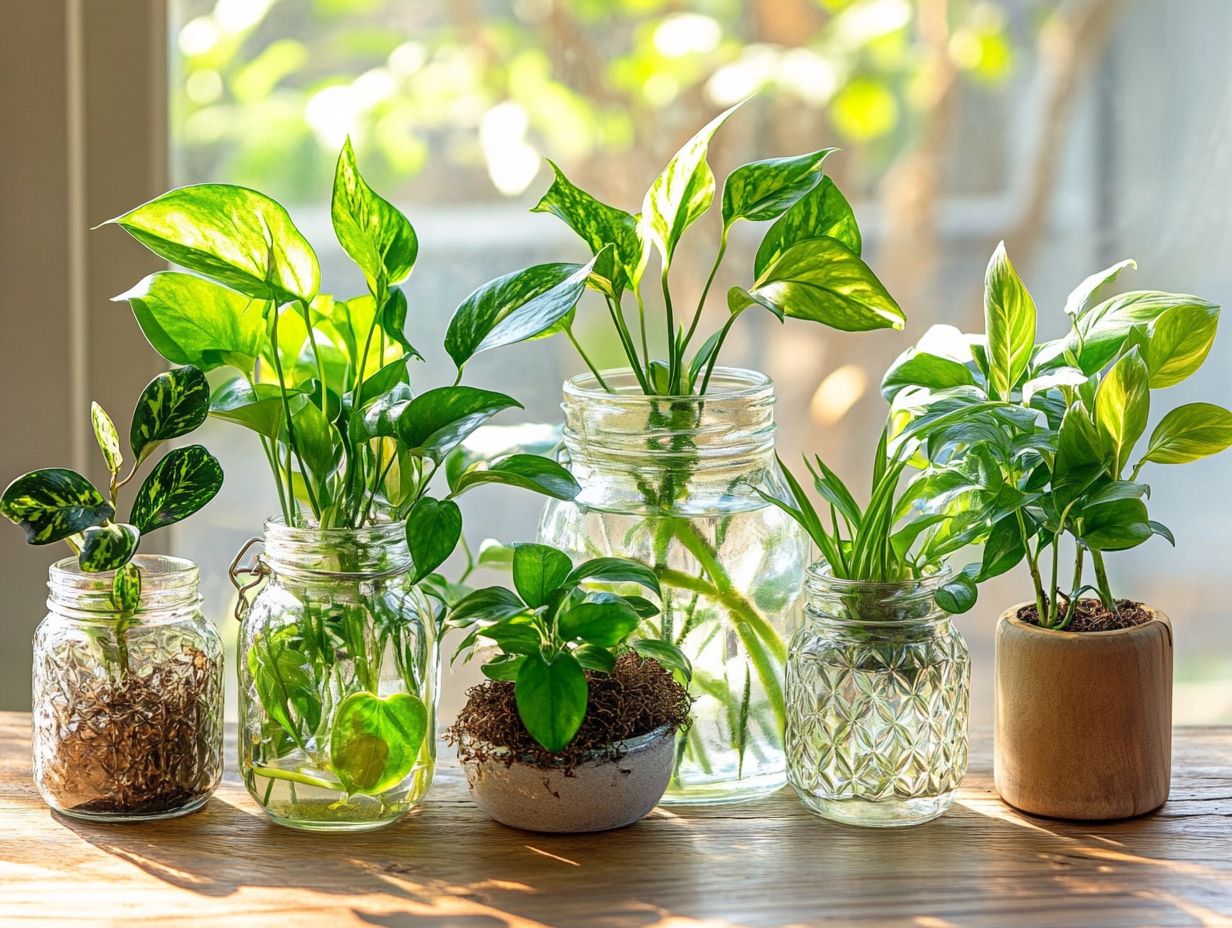
What are the best indoor plants for propagation?
- Pothos
- Spider Plant
- Monstera
- ZZ Plant
- Snake Plant
- Chinese Evergreen
What makes these plants great for propagation?
These plants are great for propagation due to their hardiness, ability to adapt to different environments, and their ability to produce new growth from cuttings.
How can I propagate these plants successfully?
To successfully propagate these plants, take stem or leaf cuttings, place them in water or soil, and provide them with proper care and maintenance.
What are the benefits of propagating indoor plants?
- Create new plants for your own collection
- Rejuvenate and revitalize older plants
- Promote growth
- Save money on buying new plants
Can I propagate other types of indoor plants?
Yes, many other types of indoor plants can be propagated, such as succulents, herbs, and flowering plants. However, the success rate may vary depending on the plant’s specific needs and characteristics.
Are there any special tips for propagating indoor plants?
It is important to use clean, sharp tools when taking cuttings to prevent the spread of disease. Also, ensure the cuttings receive enough light, warmth, and moisture to ensure successful propagation.
Get ready to watch your plants thrive! Start propagating your own plants today!

